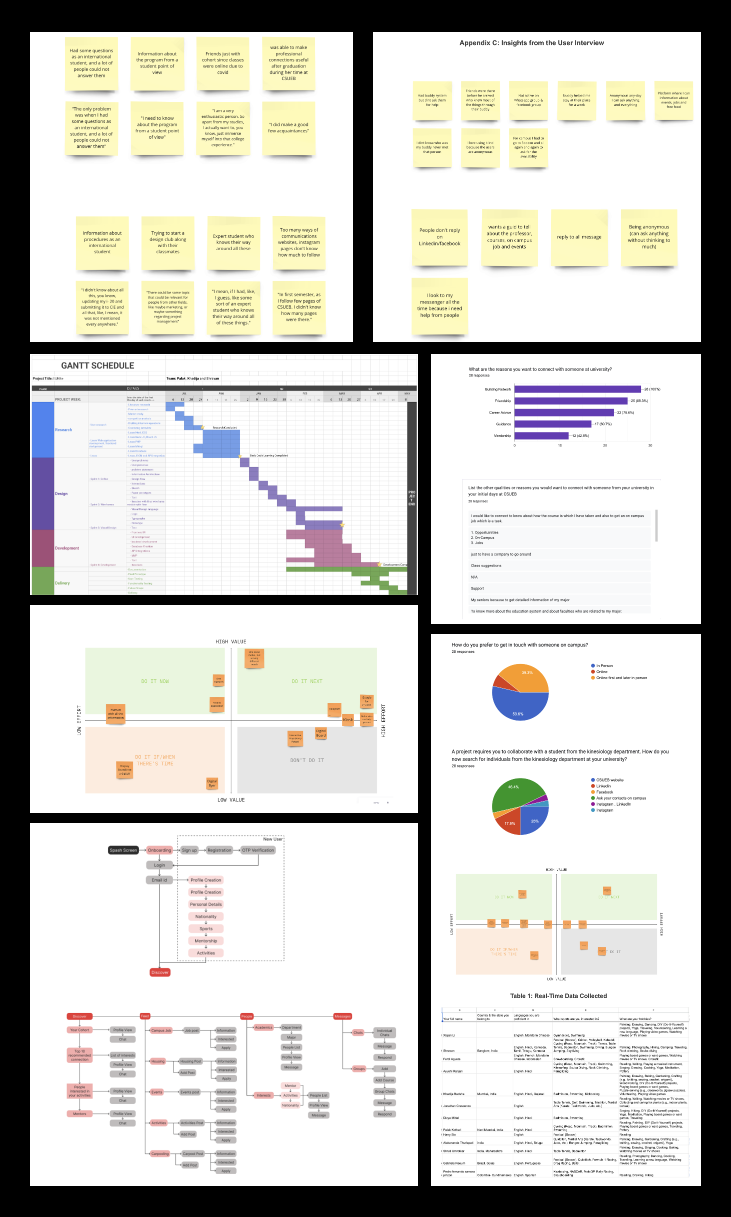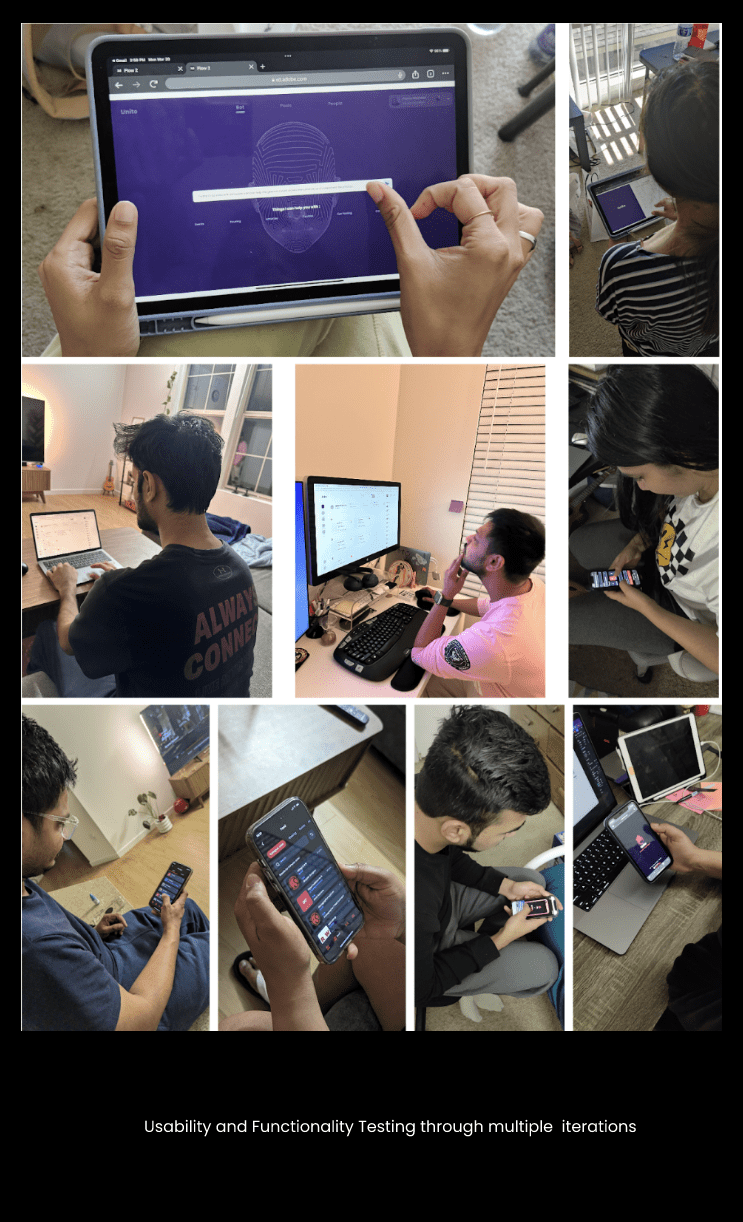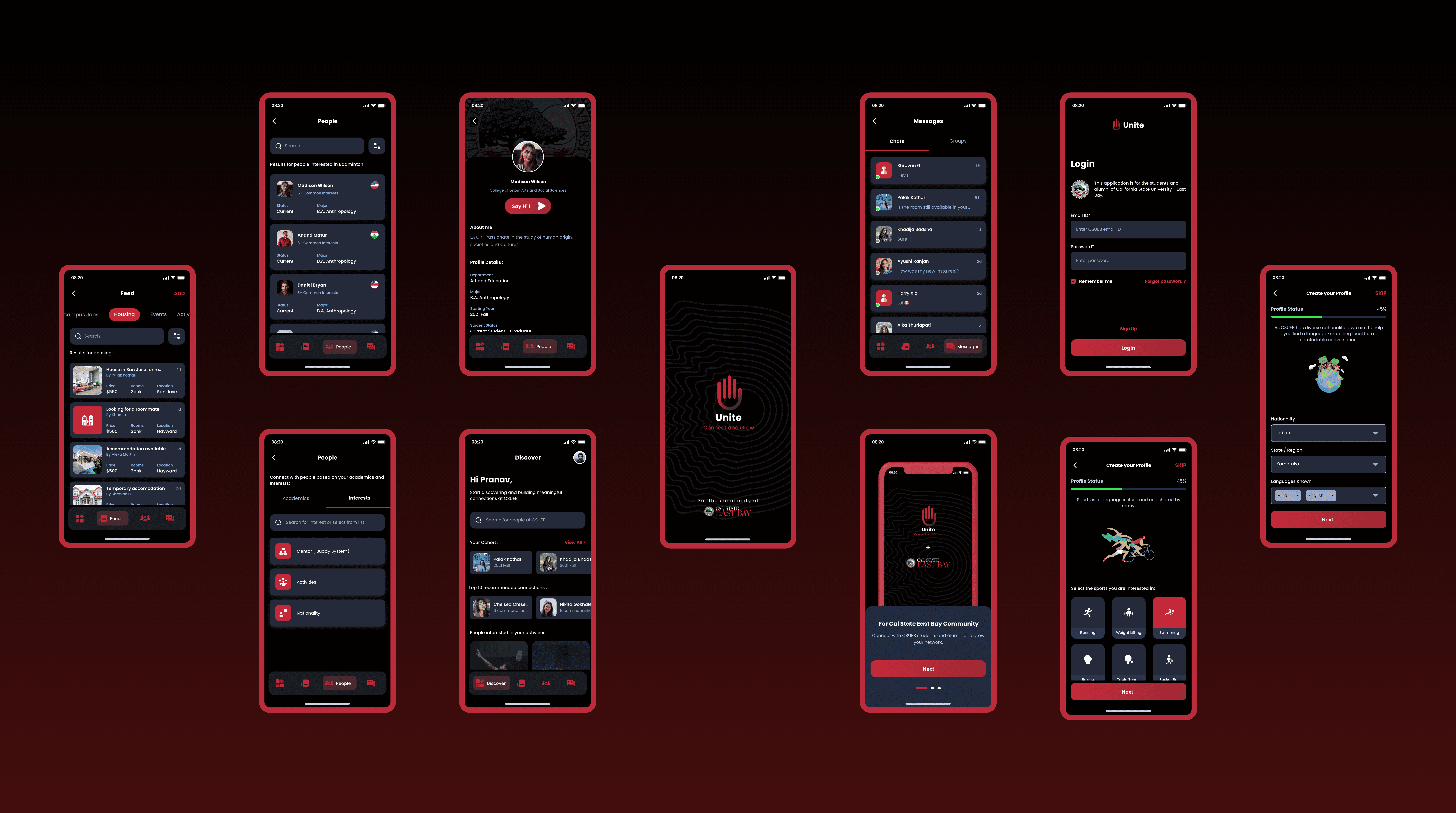UNITE
Project Summary
The UNIte app connects CSUEB students by centralizing social and informational resources, enhancing peer connections, fostering an inclusive campus culture tailored to student needs and empowering them to build a better community.
Timeline
July 2022 - May 2023
Role
Design Research, Ideation, Wire framing, Visual Design, Prototyping
Team Size
3
Problem
Freshmen at CSUEB, particularly International students, face significant challenges in forming connections due to the lack of a dedicated platform designed to facilitate student interactions. The shift to online and hybrid teaching methods, coupled with diverse class schedules, has disrupted traditional in-person engagement opportunities, making it even more difficult for students to meet and interact. Existing social media platforms like LinkedIn and Facebook, while accessible, do not cater specifically to university students’ needs, often resulting in a lack of relevant, authentic experience.
Target Audience
The target audience includes CSUEB freshmen, especially international students, facing challenges in connecting due to a lack of access and fear of reaching out when new to campus. Current students, administrators, faculty, and alumni are also targeted for improving communication and fostering a supportive university community through enhanced networking and engagement opportunities.
Challenges & Limitations
-
Integrating University Data: Challenges in effectively integrating university data into the platform to provide accurate and relevant information
-
Personalization and Privacy: Balancing the need for personalized user experiences with concerns over data privacy and security.
-
Adherence to CSUEB Guidelines: Ensuring the platform meets CSUEB’s guidelines and regulations regarding data usage, privacy, student interactions and visual design language.
-
Purpose of communication: Addressing the essential requirements and purposes for students to connect when new to campus, and empowering them to overcome their fear of reaching out.
0
User Interviews
0
User testing
0
Success Metric
Insights
After conducting numerous interviews, surveys, and user testing, we uncovered several key insights throughout different research stages, which significantly shaped the product:
-
Diverse Connection Needs : Although the students are new their purpose of finding connections or just to reach out was for various reasons and that made it inclusive of various user needs.
-
Beyond New Students : Initially, Unite focused primarily on helping new students integrate. However, we discovered that students also seek connections with alumni for job-related assistance and need access to staff for inquiries, highlighting the importance of building a comprehensive community.
-
Efficient Search Functionality : With an active student base of 15,000 per year, efficient search functionality is critical. Students often search by purpose rather than name when they are new, and making a robust and intuitive search system essential. Early interviews and testing underscored this need.
-
Social Groups : Many students created course-related discussion groups on various other social platforms, but new students were often unaware of these resources due to a lack of initial connections. This finding emphasized the need to facilitate better communication > i and awareness within the hybrid class structure.
-
Mobile first Approach : Many students prefer accessing their phones over laptops due to the convenience of quick communication and the requirement of double authentication for web logins at CSUEB. This preference informed our decision to adopt a mobile-first approach, ensuring a seamless and efficient user experience.
Solution The solution is crafted with care, empathy, and compassion, refined through numerous iterations, to foster a more inclusive community
Design Principles
User-Centric Design: Focus on addressing the specific needs and challenges faced by CSUEB students, especially freshmen and international students.
Seamless Integration: Efficiently integrate data from the university to provide accurate and relevant information and Ensure smooth interoperability with existing systems and databases.
Personalization: Personalized experiences based on user preferences and behaviors. Allow customization of profiles, interests to meet individual needs.
Scalability and Flexibility: Design the platform to handle the diverse and dynamic needs of a large student population and allowing for future expansion and integration of additional features as needed.
Inclusivity: Ensure the platform is accessible to all students, regardless of their technical proficiency or background.

.png)
.png)
.png)

User and functionality Testing
We conducted extensive user testing across multiple iterations, which allowed us to gather continuous feedback and insights. This iterative process helped us deeply understand user needs and preferences, leading to a more refined and user-centric solution.
Visual
design
Creating a design system which aligns to CSUEB design language
and bring in minimalistic modern approach.
.png)
.png)
.png)

Findings
Initially, the application’s design was complex and confusing, leading to difficulties in understanding its features. Through continuous user testing and iterative improvements, the team significantly refined the design, better aligning it with user needs. Feedback was categorized into essential design changes, experience enhancements, and interesting features. Essential changes, such as improving screen flow and implementing a design system, were prioritized. Experience enhancements, like collaborating with CSUEB for database integration and adding a college map, were noted for future development. Unfeasible interesting features were identified as already covered by other applications. The iterative process resulted in a user-friendly and functional application, enhancing students’ ability to connect and navigate university life.
Success Metric
For a product like Unite, the success metrics are subjective since the application is still in its development phases. However, it is crucial to measure engagement and impact through the feedback received:
User Validation : 98% of the users in testing phases related to the problem and felt the need for a platform like Unite, highlighting its potential impact.
Session Frequency and Duration : Tracking how often users interact with the app and the average time spent per session to assess engagement and interest.
Popular Features : Analyzing which features (e.g., profile customization, “People” search, “Feed”) are most frequently used to understand user preferences. Users found navigation easy and task completion intuitive.
Intuitive Search : Positive feedback was received for easy and intuitive search through categories on the “People” and “Feed” pages, indicating strong user relatability and perceived usefulness.
Net Promoter Score (NPS) : Measuring how likely users are to recommend the app to others, indicating overall satisfaction and perceived value. Many users recommended Unite during testing, finding it interesting and beneficial. By monitoring these metrics, we aim to refine and enhance Unite to better serve its users.
Next Steps & Future Scope
The next steps for the app involve extensive user testing and collecting real-time feedback to implement necessary improvements. Given the limited time for initial research, design, and iOS development, additional in-depth research and design iterations are crucial.
Key areas of focus include:
Integration with College Data: Ensure seamless and secure integration with college databases and student information while prioritizing privacy.
White Labeling and Expansion: Develop the app as a white-label solution to enable collaboration with students from other universities while maintaining an authentic user experience. By addressing these areas, we aim to refine the app and enhance its effectiveness in fostering a connected and supportive university community.